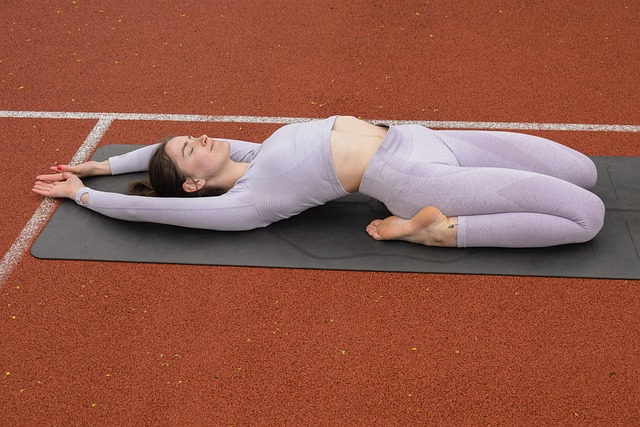Yoga for posture is an effective solution to combat poor posture caused by sedentary lifestyles or incorrect alignment. By combining stretching, strengthening exercises, mindful breathing, and meditation, regular yoga practice relieves tension, improves flexibility, promotes relaxation, and reverses negative effects of bad posture. Key poses like Cat-Cow, Downward-Facing Dog, and Child's Pose stretch and align the spine, while consistent practice ensures long-term benefits for physical and mental health. Incorporating postures like Cobra, Child's Pose, and Downward Dog alleviates tension, enhances flexibility, strengthens the core, and fosters mindfulness of body alignment, making good posture a natural daily habit.
Tension from poor posture can wreak havoc on your well-being, leading to aches, pains, and stress. This article guides you through effective self-care routines centered around yoga for alleviating tension and improving posture. We delve into the science behind posture’s impact on our bodies, explore the numerous benefits of yoga, and provide practical tips for integrating a morning yoga routine into your life. Additionally, we detail specific yoga poses tailored to strengthen and align your body for better posture.
- Understanding Posture and Its Impact on Tension
- The Benefits of Yoga for Improving Posture
- Creating a Morning Yoga Routine for Better Posture
- Incorporating Posture-Focused Yoga Poses into Your Practice
Understanding Posture and Its Impact on Tension

Poor posture, whether due to a sedentary lifestyle or incorrect alignment, can lead to increased tension and discomfort in the body. Understanding the impact of posture on our overall well-being is the first step towards alleviating tension. When we maintain poor posture, certain muscles are constantly overworked while others remain underutilized, creating an imbalance that can result in strain and tightness. This imbalance often manifests as tension in the neck, shoulders, back, and even the legs.
Yoga for posture is a holistic approach to addressing these issues. Through specific poses and breathing techniques, yoga helps to realign the body, restore muscle balance, and improve overall postural awareness. Regular practice can relieve tension, enhance flexibility, and promote a sense of calm and relaxation. By incorporating simple yet effective yoga postures into your daily routine, you can start to reverse the effects of poor posture and cultivate a healthier, more aligned body.
The Benefits of Yoga for Improving Posture

Yoga is an ancient practice renowned for its ability to promote physical and mental well-being, and it offers numerous benefits when it comes to improving posture. Through a series of stretching and strengthening exercises, yoga helps to lengthen and strengthen muscles, which can alleviate tension and tighten postural muscles. The focus on mindful breathing during yoga sessions encourages individuals to adopt more conscious postures, promoting better alignment and reducing the risk of back pain and other posture-related issues.
One of the key advantages of yoga for posture is its holistic approach. By combining physical poses, breath control, and meditation, yoga addresses the mind-body connection, helping individuals become more aware of their bodies’ needs. This heightened awareness can lead to better postural habits in daily life, ensuring that muscles remain relaxed and supported throughout the day.
Creating a Morning Yoga Routine for Better Posture

Starting your day with a morning yoga routine can be a game-changer for improving posture and alleviating tension. Dedicate just 15-20 minutes to some gentle stretches and poses focused on the back, shoulders, and hips—areas often affected by poor posture. Yoga for posture not only helps lengthen and strengthen muscles but also promotes mental clarity, setting a calm and balanced tone for the day ahead.
Choose poses like the Cat-Cow, Downward-Facing Dog, and Child’s Pose to roll, stretch, and align your spine. Incorporate side stretches and twists to target tight areas along your backbone. Remember, consistency is key; try to make this morning yoga practice a regular part of your routine.
Incorporating Posture-Focused Yoga Poses into Your Practice

Incorporating posture-focused yoga poses into your practice is an excellent way to alleviate tension and improve overall alignment. Yoga for posture involves specific asanas that target key muscle groups, helping to correct imbalances that contribute to poor posture. Poses like the Cobra, Child’s Pose, and Downward Dog are great starters; they stretch and strengthen the spine, shoulders, and back muscles, promoting better posture both on and off the mat.
By regularly practicing these yoga for posture poses, you can help prevent common issues like upper back pain, neck strain, and headaches—often linked to prolonged poor posture. These exercises enhance flexibility, improve core strength, and encourage mindfulness of your body’s alignment, ensuring that good posture becomes a natural part of your daily routine.
Poor posture can lead to physical discomfort and tension, but incorporating self-care routines like yoga can significantly alleviate these issues. By understanding the impact of posture on your body, exploring the benefits of yoga, and establishing a consistent morning routine, you can transform your overall well-being. Yoga for posture provides targeted exercises that focus on core strength and flexibility, helping to correct misalignments and reduce tension. Through dedicated practice, you can foster better posture habits, enhancing your daily life and promoting a healthier, more balanced body.
